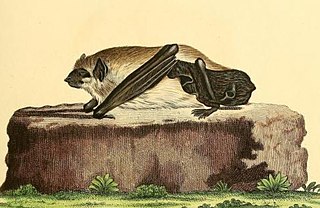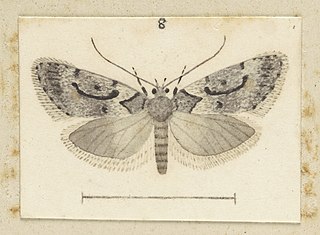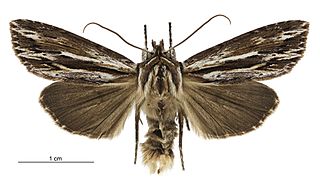Related Research Articles

The blue-billed teal, spotted teal or Hottentot teal is a species of dabbling duck of the genus Spatula. It is migratory resident in eastern and southern Africa, from Sudan and Ethiopia west to Niger and Nigeria and south to South Africa and Namibia. In west Africa and Madagascar it is sedentary.

The northern bat is the most abundant species of bat in northern Eurasia. It is found from England to Hokkaidō and south to northern India. It is closely related to the serotine bat.

Macrothylacia rubi, the fox moth, is a lepidopteran belonging to the family Lasiocampidae. It was first described by Carl Linnaeus in his 1758 10th edition of Systema Naturae.

Schreber's yellow bat or the giant house bat, is a species of vesper bat. It is found in Benin, Democratic Republic of the Congo, Ivory Coast, Ghana, Kenya, Malawi, Mozambique, Nigeria, Senegal, Tanzania, Togo, and Zimbabwe. Its natural habitats are subtropical or tropical moist lowland forests, dry savanna, and moist savanna. It is an uncommon species and its biology is poorly known. It was first described in 1774 by the German naturalist Johann Christian Daniel von Schreber, who named it Vespertilio nigrita. It was later transferred to the genus Scotophilus, making it Scotophilus nigrita.

The Blue Mountains water skink or Blue Mountains swamp-skink is a species of skink in the family Scincidae. An endangered species, it is found only in restricted parts of the mountains of southeastern Australia.
Leptopelis susanae is a species of frog in the family Arthroleptidae. It is endemic to southwest Ethiopia and known from the Gughe Mountains and Saja Forest. The specific name susanae honours Susan, the wife of the describer, Malcolm Largen. Common names Susan's tree frog and Susana's [sic] forest treefrog have been coined for this species.

Boophis goudotii is a species of frog in the family Mantellidae. It is endemic to Madagascar where it is widespread on the high plateau of central Madagascar. Records elsewhere are uncertain and many of them represent misidentifications. It is the only Malagasy frog where females are known to be vocal.
Nanorana rarica is a frog species in the family Dicroglossidae. It is endemic to western Nepal. Its type locality is the eponymous Rara Lake located in the Rara National Park.

The March dagger moth is a moth of the subfamily Chimabachinae. It is found in Europe and was first described by Michael Denis & Ignaz Schiffermüller in 1775.

Izatha manubriata is a moth of the family Oecophoridae. It is endemic to New Zealand, where it is known from the southern South Island only.

Chlorolestes fasciatus, the mountain malachite or mountain sylph is a species of damselfly in the family Synlestidae. It is found in Lesotho, South Africa and Swaziland. Its natural habitat is montane streams.

Ichneutica omoplaca is a moth of the family Noctuidae. It is endemic to New Zealand. It is widespread from the Bay of Plenty in the North Island down to Southland in the South Island. Specimens have also been collected from the Auckland Islands. It lives in a variety of habitats including beech forest clearings and tussock grasslands. This species has been recorded that some of the larval hosts of this species include Poa cita, Dactylis glomerata and it has been reared on Plantago lanceolata. The larva is undescribed but pupae have been found in a pine plantation in soil under weeds. Adults of this species are on the wing from October to March. The adult moths are variable in appearance but the diagnostic feature is the pale ochreous to white colouring between the basal streak and the costa which contrasts with the ground colour of the forewing.

Ichneutica similis is a moth of the family Noctuidae. It is endemic to New Zealand. This species is found only in certain parts of the North Island, in the western side of the South Island and on Stewart Island. It inhabits peatlands as well as inland and coastal wetlands. The life history of this species is unknown and the host species of its larvae has yet to be confirmed. It has been hypothesised that larval host species might be within the Empodisma genus as well as possibly the species Apodasmia similis.

Ethmia turnerorum is a moth in the family Depressariidae. It is found in Costa Rica, where it has been recorded from both sides of the Cordillera Volcánica de Guanacaste at altitudes ranging from 242 to 832 meters. The habitat consists of dry forests and rain forests.
Habroteleia is a genus of parasitic wasps in the family Platygastridae. There are about 9 described species in Habroteleia.

Habroteleia flavipes, is a species of wasp belonging to the family Platygastridae.
Habroteleia ruficoxa, is a species of wasp belonging to the family Platygastridae. It is found in Philippines.
Habroteleia salebra, is a species of wasp belonging to the family Platygastridae. It is described from Papua New Guinea and Indonesia.
Habroteleia soa, is a species of wasp belonging to the family Platygastridae. It is the most geographically disjunct member of the genus, which is separated by other members by the Indian Ocean. It is found in Papua New Guinea and Indonesia.
Habroteleia spinosa, is a species of wasp belonging to the family Platygastridae. It is described from Papua New Guinea and Indonesia.
References
- 1 2 Chen, H. Y.; Talamas, E. J.; Masner, L.; Johnson, N. F. (17 January 2018). "Revision of the world species of the genus Habroteleia Kieffer". ZooKeys (730): 87–122. doi: 10.3897/zookeys.730.21846 . PMC 5799745 . PMID 29416398 . Retrieved 3 April 2018.